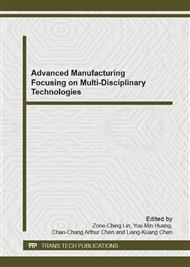[1]
Jane Zhao Yan, a high uniformity of LED lighting design and production aid, Tatung University, Mechanical Engineering 2008.
Google Scholar
[2]
Yang Chiou Jung, wafer-level packaging of the LE, Da-Yeh University, Electrical Engineering, 2007.
Google Scholar
[3]
G. Zhang, G. Burdick, F. Dai, T. Bibby, and S. Beaudoin, Assessment of Post-CMP Cleaning Mechanisms Using Statistically-Designed Experiment , Thin Solid Films, 332, pp.379-384, 1998.
DOI: 10.1016/s0040-6090(98)01038-4
Google Scholar
[4]
H. C. Wang, Effects of Inceptive Motion on Particle Detachment from Surfaces, Aerosol Science and Technology 13, pp.386-393, 1990.
DOI: 10.1080/02786829008959453
Google Scholar
[5]
F. Zhang, A. Busnaina, Submicron Particle Removal in Post-Oxide Chemical-Mechanical Planarization (CMP) Cleanin, Applied physics. A 69, pp.437-440, 1999.
DOI: 10.1007/s003390051028
Google Scholar
[6]
A. A. Busnaina, H. Lin, N. Moumen, J. W. Feng, and J. Taylor, Particle Adhesion and Removal Mechanisms in Post-CMP Cleaning Processes, IEEE Transactions on Semiconductor Manufacturing. Vol. 15, No. 4, November 2002.
DOI: 10.1109/tsm.2002.804872
Google Scholar
[7]
Kenneth W. Tobin, Jr., Thomas P. Karnowski, and Fred Lakhani, Integrated Applications of Inspection Data in the Semiconductor Manufacturing Environment, SPIE, Metrology-based Control for Micro-Manufacturing, Vol. 4275.
DOI: 10.1117/12.429361
Google Scholar
[8]
M. Lu, K. Wevers, Grey system theory and applications: a way forward, J Grey Syst, 10(1), 47-54, 2007.
Google Scholar
[9]
M. L. You, C. W. Wang, and C. K. Yeh, The development of completed grey relational analysis toolbox via Matlab, J Grey Syst, 9(1), 57-64. 2006.
Google Scholar
[10]
C.H. Li and Ming-Jong Tsai, Multi-objective Optimization of Laser Cutting of Special Shape Flash Memory Modules using Grey Relational Analysis, Optics and Laser Technology, 41 (5), pp.634-642, July, 2009.
DOI: 10.1016/j.optlastec.2008.09.009
Google Scholar
[11]
Ming-Jong Tsai and Chen-Hao Li, The use of grey relational analysis to determine laser cutting parameters for QFN packages with multiple performance characteristics, Optics and Laser Technology, 41 (8), pp.914-921, Nov. 2009.
DOI: 10.1016/j.optlastec.2009.03.006
Google Scholar
[12]
Amit Sharma and Vinod Yadava, Modelling and optimization of cut quality during pulsed Nd:YAG laser cutting of thin Al-alloy sheet for straight profile, Optics and Laser Technology, 44(1), pp.159-168, Nov. 2012.
DOI: 10.1016/j.optlastec.2011.06.012
Google Scholar


